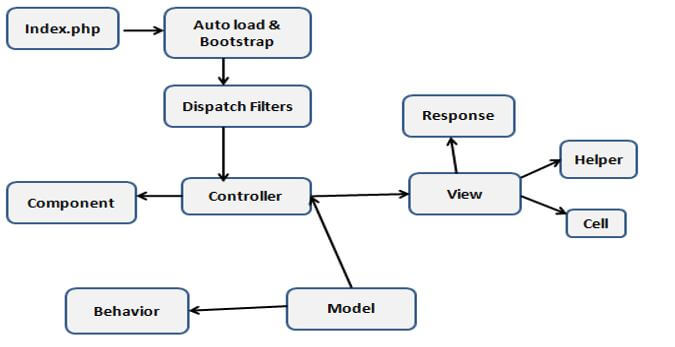Home > Article > Backend Development > CakePHP Framework
CakePHP Framework
- 王林Original
- 2024-08-29 12:58:41560browse
CakePHP is an open-source tool for developing dynamic programming or a dynamic web application. CakePHP framework uses a model view controller module to make an interactive, flexible web application. CakePHP framework supports different databases such as PostgreSQL, MySQL, etc. CakePHP was started in 2005; we can use different versions of CakePHP with some advanced features that can help develop an application in minimum time because the model view controller is easy to use and implement per the developer’s perspective.
What is CakePHP Framework?
CakePHP framework is very simple to use and implement; the most important thing about CakePHP is that it is well structured. That means we can say that it is a structured and suitable framework. With the help of that framework, we can easily develop dynamic allocation within a minimum time. Moreover, we can easily migrate the code per our requirements if any migration is required.
Start Your Free Software Development Course
Web development, programming languages, Software testing & others
The main advantage of CakePHP is that it provides a different kind of functionality to the developer with its local machine As well as keeping you from wheel-reexamining, utilizing CakePHP implies your application’s center is very much tried and is by and large continually moved along. It depends on the idea of MVC design, which assists with building PHP web applications simple with less code. CakePHP likewise assists you with isolating business rationale from the information and showing layers.
Why use CakePHP Framework?
- CakePHP is, by a long shot, one of the fastest web advancement stages.
- CakePHP permits designers to oversee the data set and SQL questions.
- It assists clients with creating strong web applications without losing their current circumstance adaptability quickly.
- Support a data set reflection library, a data set reflection library, support for PostgreSQL, SQLite, MySQL, and PEAR-DB for ADODB.
- Works with web index Friendly URLs.
- Give highlights like information approval and sterilization apparatuses that make the application secure.
- Templating with natural PHP Programming Language.
- It also provides built-in validation functionality to the developer.
- It has different components such as email, cookies, and security.
CakePHP Framework Structure
CakePHP structure Controller, Model, and View classes, yet it likewise includes a few extra classes and items that make advancement in MVC a little faster and more charming. Parts, Behaviors, and Helpers are classes that give extensibility and reusability to rapidly add usefulness to the base MVC classes in your applications.
1. Application Extensions
AppController (situated at/application/Controller/AppController.php), AppHelper (situated at/application/View/Helper/AppHelper.php), and AppModel (situated at/application/Model/AppModel.php) are incredible spots to put strategies you need to divide among all regulators, aides, or models. Even though courses aren’t classes or records, they assume a part in demands made to CakePHP. For example, course definitions advise CakePHP on how to plan URLs for regulator activities. The default conduct expects that the URL/regulator/activity/var1/var2 guides to Controller::action($var1, $var2); however, you can utilize courses to modify URLs and how they are deciphered by your application.
2. Components
A Component is a class that guides regulator rationale. A part is normally a solid match to divide among regulators (or applications). For instance, the center EmailComponent class makes making and sending messages a snap. Rather than composing a regulator technique in a solitary regulator that plays out this rationale, you can bundle the rationale so it tends to be shared. Regulators are additionally fitted with callbacks. These callbacks are accessible for your utilization if you want to embed some rationale between CakePHP’s center activities.
Callbacks accessible include:
- beforeFilter()
- afterFilter()
- beforeRender()
3. Behaviors
Essentially, Behaviors fill in as ways of adding normal; let’s consider an example of a tree; under the tree structure, we can store the user’s data so that we can easily access it. Usefulness for eliminating, adding, and moving hubs in your fundamental tree structure.
- beforeFind()
- afterFind()
- beforeValidate()
- afterValidate()
- beforeSave()
- afterSave()
- beforeDelete()
- afterDelete()
4. Helpers
A Helper is a class that guides in view rationale. Similar to a part utilized among regulators, partners permit presentational rationale to be gotten to and divided among sees. For example, one of the center assistants, JsHelper, makes AJAX requests inside, sees a lot more straightforwardly and accompanies jQuery (default), Prototype, and Mootools support.
The CakePHP request cycle is shown in the following diagram as follows:

CakePHP Framework Configuration
We need to configure different components as follows:
1. Environment Variable
Numerous advanced cloud suppliers, like Heroku, let you characterize climate factors for arrangement information. You can arrange your CakePHP through climate factors in the 12-factor application style. Climate factors permit your application to require less state, making it simpler to oversee when it is sent across various conditions, as shown in the following screenshot.

2. General Configuration
In the general configuration, we need to configure different variables as follows:
- Debug: To check to debug output.
- App, namespace: To find the application under the class.
App.baseUrl.
App.base.
App.encoding.
App.webroot.
App.wwwRoot.
After that, we need to configure the database, caching, error and exception, and logging as per our requirement.
CakePHP Framework Model
Models are dynamic portrayals of information base tables utilized in CakePHP applications for information access. They can associate with your information base, inquire about it if they are told to do so by a regulator, and save information to the data set.
Example:
Code:
<?php
Specified class name extends AppModel
{
#need to define name of model
var $specified name variable = 'required name';
}
?>
Conclusion
From the above article, we have taken in the essential idea of the CakePHP framework, and we also saw the representation and example of the CakePHP framework. We saw how and when we use the CakePHP framework from this article.
The above is the detailed content of CakePHP Framework. For more information, please follow other related articles on the PHP Chinese website!

